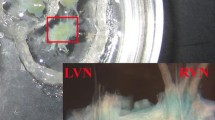Summary
-
1.
Effects of O2 and of statocystectomy on gravity orientation ofLymnaea stagnalis were studied in a nearly isotropic light field.
-
2.
In conformity with previous results O2 affects the sign of gravity orientation and the orientation angle during geotactic behaviour (Fig. 2, Tables 1 and 2).
-
3.
Statocystectomy experiments support the previously published hypothesis (Janse 1981) that peripheral interactions exist between O2-receptors and statocysts (Fig. 2, Tables 1 and 2).
-
4.
Without statocystsLymnaea can still orientate in the gravitational field. The sign of this type of orientation is affected by theP O2 (especially of the lung contents), the orientation angle, however, is not (Fig. 2, Tables 1 and 2).
-
5.
Apart from the statocystsLymnaea can also use the buoyancy of that part of the body which is contained in the shell for positive as well as for negative geotaxis (Fig. 3, Table 3). Indications were obtained that proprioperception plays a role in this type of (buoyancy) orientation.
-
6.
Experiments in which the types of gravity orientation were artificially induced to counteract each other indicate that in water buoyancy orientation operates continuously but that the statocysts determine positive as well as negative geotaxis (Figs. 4 and 5, Tables 4 and 5).
-
7.
Apart from the gravity orientation mechanism proper, O2-conditions and statocysts also influence mechanisms which determine steering and creeping. The nature of these effects indicate that steering, creeping and the orientation angle during geotactic behaviour are induced by different neuronal mechanisms (Fig. 2, Tables 1 and 2).
-
8.
Experiments in which geotaxis was studied at increasing time intervals after statocystectomy showed that the statocysts do not regenerate. Moreover, indications were obtained that as yet unknown internal factors also affect gravity orientation inL. stagnalis (Fig. 6).
Similar content being viewed by others
References
Audesirk G, Audesirk T (1980a) Complex mechanoreceptors inTritionia diomedea. I. Responses to mechanical and chemical stimuli. J Comp Physiol 141:101–109
Audesirk G, Audesirk T (1980b) Complex mechanoreceptors inTritonia diomedea. II. Neuronal correlates of a change in behavioral responsiveness. J Comp Physiol 141:111–122
Geuze JJ (1968) Observations on the function and the structure of the statocysts ofLymnaea stagnalis (L). Neth J Zool 18:155–204
Henderson AE (1963) On the underwater weight of freshwater snails. Z Vergl Physiol 46:467–490
Heyer CB, Kater SB, Karlsson UL (1973) Neuromuscular systems in molluscs. Am Zool 13:247–270
Horn E (1975) The contribution of different receptors to gravity orientation in insects. Fortschr Zool 23:1–20
Janse C (1974) A neurophysiological study of the peripheral tactile system of the pond snailLymnaea stagnalis (L.). Neth J Zool 24:93–161
Janse C (1981) The effect of oxygen on gravity orientation in the pulmonate snailLymnaea stagnalis. J Comp Physiol 142:51–59
Jones JD (1961) Aspects of respiration inPlanorbis corneus L. andLymnaea stagnalis L. (Gastropoda:Pulmonata). Comp Biochem Physiol 4:1–29
Joosse J, Lever J (1959) Techniques of narcotization and operation for experiments withLymnaea stagnalis (Gastropoda, Pulmonata). Proc K Ned Akad Wet C 62:145–149
Kaiser P (1959) Die Leistungen des Flimmerepithels bei der Fortbewegung der Basommatophoren. Z Wiss Zool 162:368–393
Kanda S (1916a) Studies on the geotropism of the marine snailLittorina littorea. Biol Bull 30:58–84
Kanda S (1916b) The geotropism of freshwater snails. Biol Bull 30:85–97
Kovac MP, Davis WJ (1980a) Neural mechanisms underlying behavioral choice inPleurobranchaea. J Neurophysiol 43:469–487
Kovac MP, Davis WJ (1980b) Reciprocal inhibition between feeding and withdrawal behaviors inPleurobranchaea. J Comp Physiol 139:77–86
Laverack MS, Bailey DF (1963) Movement receptors inBuccinum undatum. Comp Biochem Physiol 8:289–298
Markl H (1975) The perception of gravity and of angular acceleration in invertebrates. In: Kornhuber HH (ed) Handbook of sensory physiology, vol VI 1. Springer, Berlin Heidelberg New York, pp 17–74
McClary A (1966) Statocyst function inPomacea paludosa. Malacologia 3:419–431
McClary A (1967) Statocyst function inPomacea paludosa (Say). Proc Symp Moll 1:379–385
Sandeman DC (1976) Spatial equilibrium in the arthropods. In: Mill PJ (ed) Structure and function of proprioreceptors in the invertebrates. Chapman and Hall, London, pp 485–528
Scheirer CJ, Ray WS, Hare N (1976) The analysis of ranked data derived from completely randomized factorial designs. Biometrics 32:429–434
Schöne H, Neil DM (1977) The integration of leg postilion receptors and their integration with statocyst inputs in spiny lobsters (Reactions ofPalinurus vulgaris to substrate tilt III). Mar Behav Physiol 5:45–59
Schöne H, Neil DM, Scapini F (1978) The influence of substrate contact on gravity orientation (Substrate orientation in spiny lobster V). J Comp Physiol 126:293–295
Sokal RR, Rohlf FJ (1969) Biometry. Freeman, San Francisco
Steen WJ van der, Hoven NP van den, Jager JC (1969) A method for breeding and studying freshwater snails under continuous water change, with some remarks on growth and reproduction inLymnaea stagnalis L. Neth J Zool 19:131–139
Wolff HG (1975) Statocysts and geotactic behaviour in gastropod molluscs. Fortschr Zool 23:63–84
Author information
Authors and Affiliations
Rights and permissions
About this article
Cite this article
Janse, C. Sensory systems involved in gravity orientation in the pulmonate snailLymnaea stagnalis . J. Comp. Physiol. 145, 311–319 (1982). https://doi.org/10.1007/BF00619335
Accepted:
Issue Date:
DOI: https://doi.org/10.1007/BF00619335




